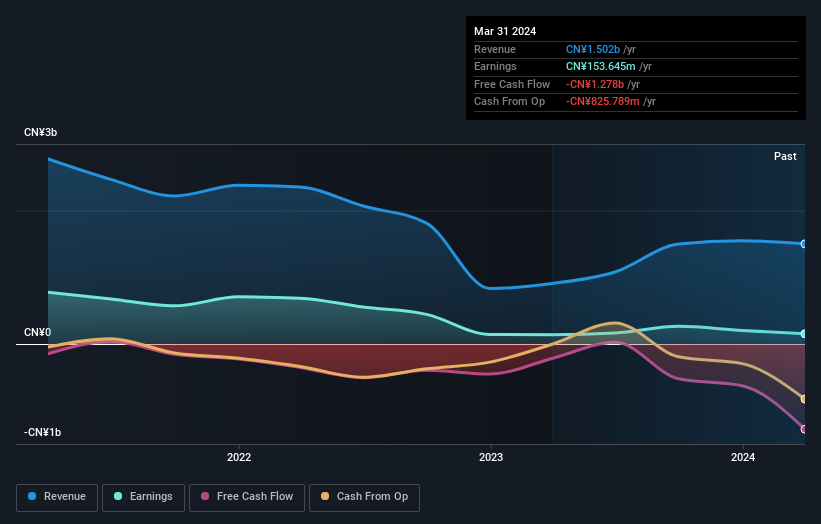- China
- /
- Real Estate
- /
- SZSE:002016
Insiders were the key beneficiaries as Guangdong Shirongzhaoye Co., Ltd.'s (SZSE:002016) market cap rises to CN¥5.4b

Key Insights
- Significant insider control over Guangdong Shirongzhaoye implies vested interests in company growth
- 54% of the company is held by a single shareholder (Shezeng Liang)
- Past performance of a company along with ownership data serve to give a strong idea about prospects for a business
A look at the shareholders of Guangdong Shirongzhaoye Co., Ltd. (SZSE:002016) can tell us which group is most powerful. We can see that individual insiders own the lion's share in the company with 74% ownership. In other words, the group stands to gain the most (or lose the most) from their investment into the company.
Clearly, insiders benefitted the most after the company's market cap rose by CN¥607m last week.
Let's take a closer look to see what the different types of shareholders can tell us about Guangdong Shirongzhaoye.
View our latest analysis for Guangdong Shirongzhaoye

What Does The Institutional Ownership Tell Us About Guangdong Shirongzhaoye?
Institutional investors commonly compare their own returns to the returns of a commonly followed index. So they generally do consider buying larger companies that are included in the relevant benchmark index.
Institutions have a very small stake in Guangdong Shirongzhaoye. That indicates that the company is on the radar of some funds, but it isn't particularly popular with professional investors at the moment. If the business gets stronger from here, we could see a situation where more institutions are keen to buy. When multiple institutional investors want to buy shares, we often see a rising share price. The past revenue trajectory (shown below) can be an indication of future growth, but there are no guarantees.

Guangdong Shirongzhaoye is not owned by hedge funds. Shezeng Liang is currently the company's largest shareholder with 54% of shares outstanding. With such a huge stake in the ownership, we infer that they have significant control of the future of the company. Meanwhile, the second and third largest shareholders, hold 20% and 0.5%, of the shares outstanding, respectively.
Researching institutional ownership is a good way to gauge and filter a stock's expected performance. The same can be achieved by studying analyst sentiments. As far as we can tell there isn't analyst coverage of the company, so it is probably flying under the radar.
Insider Ownership Of Guangdong Shirongzhaoye
While the precise definition of an insider can be subjective, almost everyone considers board members to be insiders. Company management run the business, but the CEO will answer to the board, even if he or she is a member of it.
Most consider insider ownership a positive because it can indicate the board is well aligned with other shareholders. However, on some occasions too much power is concentrated within this group.
Our information suggests that insiders own more than half of Guangdong Shirongzhaoye Co., Ltd.. This gives them effective control of the company. So they have a CN¥4.0b stake in this CN¥5.4b business. Most would argue this is a positive, showing strong alignment with shareholders. You can click here to see if those insiders have been buying or selling.
General Public Ownership
The general public-- including retail investors -- own 22% stake in the company, and hence can't easily be ignored. While this size of ownership may not be enough to sway a policy decision in their favour, they can still make a collective impact on company policies.
Next Steps:
I find it very interesting to look at who exactly owns a company. But to truly gain insight, we need to consider other information, too. Consider for instance, the ever-present spectre of investment risk. We've identified 3 warning signs with Guangdong Shirongzhaoye (at least 2 which are a bit unpleasant) , and understanding them should be part of your investment process.
Of course this may not be the best stock to buy. Therefore, you may wish to see our free collection of interesting prospects boasting favorable financials.
NB: Figures in this article are calculated using data from the last twelve months, which refer to the 12-month period ending on the last date of the month the financial statement is dated. This may not be consistent with full year annual report figures.
New: Manage All Your Stock Portfolios in One Place
We've created the ultimate portfolio companion for stock investors, and it's free.
• Connect an unlimited number of Portfolios and see your total in one currency
• Be alerted to new Warning Signs or Risks via email or mobile
• Track the Fair Value of your stocks
Have feedback on this article? Concerned about the content? Get in touch with us directly. Alternatively, email editorial-team (at) simplywallst.com.
This article by Simply Wall St is general in nature. We provide commentary based on historical data and analyst forecasts only using an unbiased methodology and our articles are not intended to be financial advice. It does not constitute a recommendation to buy or sell any stock, and does not take account of your objectives, or your financial situation. We aim to bring you long-term focused analysis driven by fundamental data. Note that our analysis may not factor in the latest price-sensitive company announcements or qualitative material. Simply Wall St has no position in any stocks mentioned.
About SZSE:002016
Guangdong Shirongzhaoye
Engages in the development and operation of real estate properties in China.
Excellent balance sheet slight.

